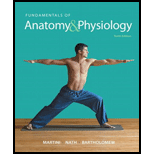
Which of the following chemical equations illustrates a typical decomposition reaction?
Trending nowThis is a popular solution!

Chapter 2 Solutions
Fundamentals of Anatomy & Physiology Plus Mastering A&P with eText - Access Card Package (10th Edition) (New A&P Titles by Ric Martini and Judi Nath)
- For this reaction: 6CO2 + 6H2O → C6H12O6 + 6O2, the products have 2760 kJ/mole more free energy than the reactants. So, which of the following statements best describes the reaction? a The reaction is endergonic because it converts molecules with less free energy to those with more free energy. b The reaction is exergonic because it converts molecules with less free energy to those with more free energy. c The reaction is exergonic because it converts molecules with more free energy to those with less free energy d The reaction is endergonic because it converts molecules with more free energy to those with less free energy.arrow_forwardThe reaction quotient is Q=1.6×10-26 Part B What pH is needed to produce this value of Q if the concentration and pressure values are [Br2]=2.50×10−4M , [Br−]=11.65M, [SO42−]=9.50M, and PSO2=3.50×10−5atm ? Express your answer numerically to two decimal places.arrow_forwardIn the following reaction in aqueous solution, the acid reactant is and its conjugate base product is CH;COOH + NH3 CH;CO0 + NH,"arrow_forward
- The equilibrium constant for the reaction Q → R is 25. Solve, (a) If 50 μM of Q is mixed with 50 μM of R, which way will the reaction proceed to generate more Q or more R? (b) Calculate the equilibrium concentrations of Q and R.arrow_forwardIdentify any combination reactions. (Select all that apply.) C4H10 + O2 → CO2 + H2O S8 + O2 → SO3 NaNO3 → NaNO2 + O2 HgO → Hg + O2 Ga + H2SO4 → Ga2(SO4)3 + H2 AgCl2 + H2 → Ag + HCl none of the above Identify any decomposition reactions. (Select all that apply.) C4H10 + O2 → CO2 + H2O S8 + O2 → SO3 NaNO3 → NaNO2 + O2 HgO → Hg + O2 Ga + H2SO4 → Ga2(SO4)3 + H2 AgCl2 + H2 → Ag + HCl none of the abovearrow_forwardA monoprotic weak acid, HA, dissociates in water according to the reaction HA(aq) = H+ (aq) + A¯(aq) The equilibrium concentrations of the reactants and products are [HA] = 0.220 M, [H+] = 3.00 × 10−4 M, and [A¯] = 3.00 × 10−4 M. Calculate the value of pKa for the acid HA. pKa =arrow_forward
- A certain first order reaction has the rate law Rate = k[A] with k=0.0068 sec-1. If the initial concentration of A is 0.75 M, what will be the concentration of A after 1 minute? What is the half-life for this reaction? How much time will it take for 75% of A to react? How much A will be left after the passage of three half-lives? What is the initial rate of the reaction?arrow_forwardin which of the following alternatives is the greatest amount of energy released from the hydrogenation of:a) 1 mole propeneb) 1 mole of butadiene 1.3c) 1 mole pentyn-2d) 3 moles of ethenearrow_forwardThe following questions are based on the reaction A+ B ↔ C+D shown in Figure 8.1. 1. Which of the following terms best describes the progress of the reaction with respect to free energy change? a) endergonic, ∆G> 0 b) exergonic, ∆G> 0 c) exergonic, ∆G< 0 d) endergonic, ∆G< 0 2. Which of the following in Figure 8.1 remains unchanged by having an enzyme included? a) b b) d c) a d) c 3. The part labeled “C” on the above graph represents a) Energy of activation without enzyme b) Energy of activation with enzyme c) Amount of free energy released d) amount of energy required for the reaction progressarrow_forward
- This is a plot under standard conditions of free energy corresponding to a chemical reaction of A+B to C+D. What will happen if only C+D are present under standard temperature and pressure? Please explain why.arrow_forward1) what is the equilibrium constant for the reaction A + CT AT+ C? Show calculations. 2) the imagearrow_forwardShow how the Michaelis-Menten Equation was derived from this reaction. k1 k2 E + S = e ES E + Parrow_forward
 Human Anatomy & Physiology (11th Edition)BiologyISBN:9780134580999Author:Elaine N. Marieb, Katja N. HoehnPublisher:PEARSON
Human Anatomy & Physiology (11th Edition)BiologyISBN:9780134580999Author:Elaine N. Marieb, Katja N. HoehnPublisher:PEARSON Biology 2eBiologyISBN:9781947172517Author:Matthew Douglas, Jung Choi, Mary Ann ClarkPublisher:OpenStax
Biology 2eBiologyISBN:9781947172517Author:Matthew Douglas, Jung Choi, Mary Ann ClarkPublisher:OpenStax Anatomy & PhysiologyBiologyISBN:9781259398629Author:McKinley, Michael P., O'loughlin, Valerie Dean, Bidle, Theresa StouterPublisher:Mcgraw Hill Education,
Anatomy & PhysiologyBiologyISBN:9781259398629Author:McKinley, Michael P., O'loughlin, Valerie Dean, Bidle, Theresa StouterPublisher:Mcgraw Hill Education, Molecular Biology of the Cell (Sixth Edition)BiologyISBN:9780815344322Author:Bruce Alberts, Alexander D. Johnson, Julian Lewis, David Morgan, Martin Raff, Keith Roberts, Peter WalterPublisher:W. W. Norton & Company
Molecular Biology of the Cell (Sixth Edition)BiologyISBN:9780815344322Author:Bruce Alberts, Alexander D. Johnson, Julian Lewis, David Morgan, Martin Raff, Keith Roberts, Peter WalterPublisher:W. W. Norton & Company Laboratory Manual For Human Anatomy & PhysiologyBiologyISBN:9781260159363Author:Martin, Terry R., Prentice-craver, CynthiaPublisher:McGraw-Hill Publishing Co.
Laboratory Manual For Human Anatomy & PhysiologyBiologyISBN:9781260159363Author:Martin, Terry R., Prentice-craver, CynthiaPublisher:McGraw-Hill Publishing Co. Inquiry Into Life (16th Edition)BiologyISBN:9781260231700Author:Sylvia S. Mader, Michael WindelspechtPublisher:McGraw Hill Education
Inquiry Into Life (16th Edition)BiologyISBN:9781260231700Author:Sylvia S. Mader, Michael WindelspechtPublisher:McGraw Hill Education





